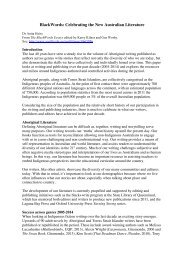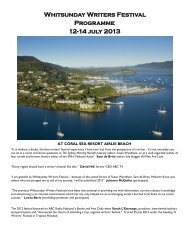7209743364812265548-Aboriginal-Literature-for-Children
7209743364812265548-Aboriginal-Literature-for-Children
7209743364812265548-Aboriginal-Literature-for-Children
Create successful ePaper yourself
Turn your PDF publications into a flip-book with our unique Google optimized e-Paper software.
out, through text and images, the differences between life in the home she was removed to (alonely, regimented dormitory life) and the family life she misses and dreams about (withstorytelling around the campfire, mornings with her mother on their verandah, and fishingand swimming in the river).Works like these are essential <strong>for</strong> use in the classroom, so that Australian adults and childrencan understand their sense of privilege – past and present – by learning about the lives ofearlier generations of <strong>Aboriginal</strong> children removed from their families.Language reclamation and maintenanceLanguage reclamation and maintenance are priorities <strong>for</strong> <strong>Aboriginal</strong> Australia because, of the250 different Indigenous languages (most with several dialects) estimated at the time of FirstContact, less than one tenth are still strong languages of everyday communication <strong>for</strong>Australia’s First Peoples, and fragmented collections of words are all that remain of manyonce full and complex languages:According to the NILS report, among the original 250 or so languages, only about145 Indigenous languages are still spoken to some degree. Many languages are notfully spoken by anybody, and only some words and phrases are remembered. Lessthan 20 languages are considered to be strong in the sense that they are still spokenby all generations. (Obata and Lee)Titles like Down the Hole, discussed above, which offer some level of bi-lingualism, using inthis case words and phrases in Alyawarr accompanied by English translation, are moreculturally valuable than many mono-lingual titles. <strong>Aboriginal</strong> words and phrases in children’sbooks such Down the Hole allow children from the language group to practice their ownlanguages, while other children—<strong>Aboriginal</strong> and non-<strong>Aboriginal</strong> alike—can also learn someof the rich Yankunytjatjara, Kokatha and Matutjara languages. It is also a reminder to botheducators and students that there were, and remain, distinctly different <strong>Aboriginal</strong> languagesin Australia.There is a further unique feature of <strong>Aboriginal</strong> authored children’s books that weavelanguage throughout that needs mention and that is the books written by very young<strong>Aboriginal</strong> kids. The Cowboy Frog (Magabala, 2003), written and illustrated by nine-yearoldHylton Laurel, is targeted at three-to-six year olds. It is a story about a brave, blue hatwearing,green frog near Noonkanbah Crossing who loved to fish <strong>for</strong> barramundi and wasknown as “the Cowboy Frog”. The story teaches kids that animals should only be hunted andkilled <strong>for</strong> the purpose of eating and surviving, not <strong>for</strong> fun or sport. The illustrations areauthentic, obviously drawn by a young person. But its richness is in its bi-lingual textcombining English and the Walmajarii language (translations provided by YangkanaMadeleine Laurel).The Cowboy Frog is part of Magabala’s Uupababa series, a collection of titles filled withbright illustrations <strong>for</strong>, and sometimes by, young children. The word uupababa is an<strong>Aboriginal</strong> word and is used extensively in the Broome area (where Magabala is located). Itloosely translates as meaning ‘little child’ or ‘baby’. The Cowboy Frog won an achievementaward in the Multicultural Book Competition in 2004 and has set young Hylton up as astoryteller with promise.




